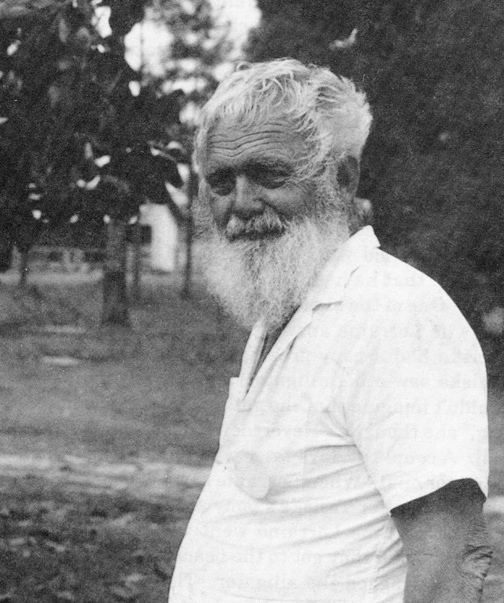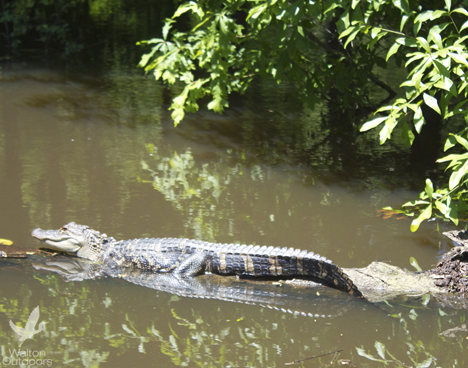
By DeLene Sholes
Note: This story was originally published in the historical book Of Days Gone By – Reflections of South Walton County, Florida by South Walton Three Arts Alliance. Republished with permission. You may find a copy of the book that includes many short stories about our area’s colorful history at the Coastal Branch Library.
Long ago, when it was legal to trap alligators, and sometimes when it wasn’t, Point Washington native George Morgan and his father-in-law, Alfred Barrett, would go to the rivers at night to hunt the reptiles. In later years, George’s friend, Franciel Dickey, or his teenage son Clay would accompany this bold and daring man when he went to rivers and lakes to trap gators. The trappers would shine a light in the gator’s eyes and shoot it with a gun. They claimed they could tell how big the gator was by the size of its eyes.
When the alligator population decreased and the alligator became an endangered species, the State made it illegal to trap them. George had a hunter’s instinct, having trapped gators, raccoons, otters, and other animals all his life. The tall, rugged, retired Navy man with the grizzly beard and a sailor’s salty language, applied to the State’s Fish and Game Commission for the job of alligator trapper, and received a commission. His territory extended from Panama City Beach to Ft. Walton Beach, and if the State agency got a complaint about a gator troubling people his area, they contacted George.

The trapper made few preparations for the hunt – the only things that he needed were his hook and his bang stick, a long stick with a bullet projectile on the end. It was illegal to use a shotgun to kill a gator, because of the danger to other people. George seldom wore shoes when he went for the gators. When he received a call about a nuisance alligator, George would go to the specified place and set a hook. The hook looked like a fishhook, and was about the size of a man’s thumb and forefinger.
When the alligator went for the piece of rotten chicken on the hook, he pulled it under water and chewed on it for a day or two. A few days later, George would go back to check the hook. If George found a gator, he would kill it with has bang stick, which went off like a shotgun.
George cared little for social amenities, and sometimes his salty language and less than tactful comments offended and frightened newcomers, who may have convinced themselves that their nuisance alligator would only be relocated-not killed. He didn’t hesitate to tell the callers that the alligator had eaten their missing dog or to give them gory details of the killing. His boss, Jimmy McDaniel, who from time to time had to smooth feathers that the trapper had ruffled with his comments, said that George “was the most colorful trapper” that he had.
One of the biggest alligators that George ever killed was on Peach Creek. His wife Lorraine answered a call from the Blackwell home. Their daughter Treiska had a pony grazing down by the creek. It was late afternoon when Treiska saw a big alligator, and she thought it was after her pony. Lorraine couldn’t imagine that the gator was after the horse. “Maybe he’s after her little dog,” she thought. Nevertheless, she went with George when he answered the call. A couple of days later when he checked the hook, he found a twelve foot alligator on it. When Lorraine saw how big the gator was, she thought it might have after Treiska’s pony after all.
One time Lorrraine went with George to trap an alligator at Grayton Beach. When they got to the beach, they found tracks in the sand where someone had dragged the alligator. The couple followed the tracks in the beach vehicle. It was the first time Lorraine had ridden on the beach, and it seemed like a very long ride. She was afraid they would find whoever had gotten the gator and there would be a confrontation between the trapper and the poacher.
They followed the sandy trail up into the dunes in the Campbell Lake area. Lorraine was greatly relieved to find that nobody was there except the alligator. The poachers had killed it for the beat in its tail and left its carcass to rot. It was unusual to see an alligator on the beach, and this one’s killers had dealt with it poorly by leaving it in the sand. There was no confrontation with the poachers, but if there had been one, the alligator trapper would doubtless have made them feel the contempt that he felt for their irresponsible behavior.
George Morgan was a true hunter who believed in making the most of his catch. He skinned and salted the alligator hides to be auctioned by the State each year and sold the meat to local restaurants. Lorraine was not always happy to receive the squirrel or rabbit that George brought home for her to prepare for dinner. When she protested, George would proudly reminder her, “We’re living off the land, Babe.”
Side notes:
• Learn more about living around alligators by downloading this brochure: Alligator_Brochure
• In the State of Florida, live American alligators cannot be taken from the wild without a valid Alligator Trapping License. Learn more by clicking here.
